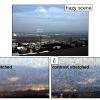Free Online Productivity Tools
i2Speak
i2Symbol
i2OCR
iTex2Img
iWeb2Print
iWeb2Shot
i2Type
iPdf2Split
iPdf2Merge
i2Bopomofo
i2Arabic
i2Style
i2Image
i2PDF
iLatex2Rtf
Sci2ools
CVPR
2009
IEEE
2009
IEEE
Polarization: Beneficial for Visibility Enhancement?
When imaging in scattering media there is a need to enhance
visibility. Some approaches have used polarized images
in this context with apparent success. These methods
take advantage of the fact that the path radiance (airlight)
is partially polarized. However, mounting a polarizer attenuates
the signal associated with the object. This attenuation
degrades the image quality. Thus, a question arises: is the
use of a polarizer worth the mentioned loss? The ability
to see objects is limited by noise. Therefore, in this work
we analyze the change in signal to noise ratio (SNR) following
the use of a polarizer or a dehazing process. Typically,
methods use either one polarized image (with minimum
path radiance) or two polarized images corresponding
to extrema of the path radiance. We show that if the only
goal is signal discrimination over noise (and not color or
radiance recovery) in haze, the use of polarization in both
approaches is unnecessary: polarization rarely improve...
| Added | 09 May 2009 |
| Updated | 10 Dec 2009 |
| Type | Conference |
| Year | 2009 |
| Where | CVPR |
| Authors | Tali Treibitz, Yoav Y. Schechner |
Comments (0)

